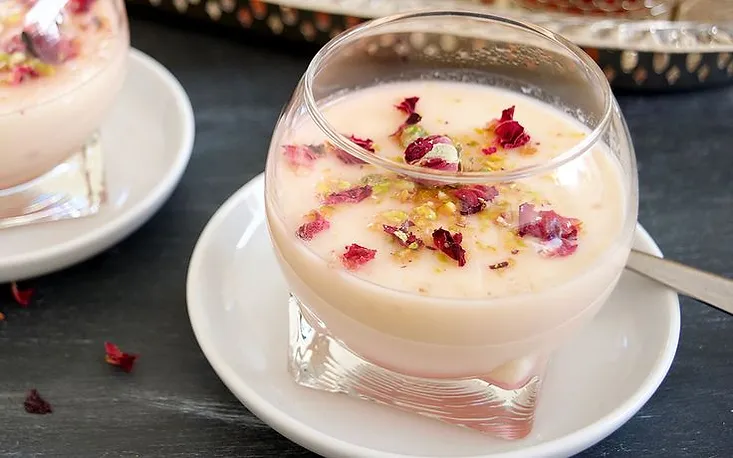Mahalabia: A Taste of Tradition in Every Spoonful

Mahalabia, a cherished dessert in Middle Eastern cuisine, is a creamy, fragrant, and delicate pudding infused with rose water. This delightful treat, often enjoyed during Ramadan or as a refreshing dessert on a warm day, is a testament to the rich culinary heritage of the region. As we explore the allure of Mahalabia, we’ll also delve into the broader world of traditional Middle Eastern desserts and discuss the importance of sustainability in Lebanese food.
What is Mahalabia?
Mahalabia (Rose Water Milk Pudding), also known as Muhallabia, is a rose water milk pudding that has been enjoyed in the Middle East for centuries. Its origins are believed to trace back to the Sassanid Empire, but it has since become a staple dessert in many Middle Eastern countries, including Lebanon, Egypt, and Turkey.
This dessert is made from simple ingredients: milk, sugar, cornstarch, and rose water. The mixture is gently heated until it thickens, then poured into bowls and chilled until set. The result is a silky, smooth pudding that melts in your mouth, with the subtle aroma of rose water adding a touch of elegance.
Traditional Middle Eastern Desserts: A Culinary Journey
Mahalabia is just one of many traditional Middle Eastern desserts that showcase the region's rich culinary traditions. These desserts often feature ingredients like nuts, honey, dates, and fragrant spices, creating a unique blend of flavors and textures.
Baklava is perhaps one of the most famous Middle Eastern desserts. Layers of phyllo pastry are filled with a mixture of chopped nuts and sweetened with syrup or honey, creating a dessert that is both crunchy and sticky.
Kunafa is another beloved treat, especially in Lebanon. This dessert is made with shredded phyllo dough or semolina, layered with a sweet cheese filling, and soaked in sugar syrup. The combination of crispy pastry and soft, gooey cheese is irresistible.
Qatayef, often prepared during Ramadan, are small pancakes filled with nuts or sweet cheese, folded into a crescent shape, and then fried or baked. They are then drizzled with syrup, offering a perfect balance of sweetness and crunch.
These traditional desserts are more than just sweet treats; they are a reflection of the region’s culture, history, and the importance of hospitality. Sharing these desserts with family and friends is a cherished tradition, especially during religious and cultural celebrations.
Best Lebanese Food and Sustainability
Lebanese cuisine is renowned for its fresh ingredients, bold flavors, and diverse dishes. From mezze spreads to grilled meats and vegetarian dishes, Lebanese food offers something for everyone. However, as with many global cuisines, there is a growing emphasis on sustainability in Lebanese food.
Best Lebanese food and sustainability in food practices involves using locally sourced ingredients, reducing food waste, and supporting small-scale farmers. In Lebanon, this movement is gaining momentum as chefs and home cooks alike embrace traditional farming practices and seasonal eating.
Many traditional Lebanese dishes are inherently sustainable. For example, Tabbouleh, a salad made with parsley, tomatoes, and bulgur, uses ingredients that are readily available and grown locally. Mujadara, a dish made with lentils and rice, is another example of a sustainable dish that is both nutritious and affordable.
Even in desserts, there is a trend towards using natural sweeteners like honey and dates instead of processed sugar. Mahalabia, with its simple ingredients, is a great example of a dessert that can be made sustainably.
FAQs about Mahalabia and Middle Eastern Desserts
Q: What is Mahalabia made of?
A: Mahalabia is made from milk, sugar, cornstarch, and rose water. It’s a simple yet elegant dessert that is often garnished with nuts or shredded coconut.
Q: Is Mahalabia served hot or cold?
A: Mahalabia is typically served cold, making it a refreshing dessert, especially in warm weather.
Q: Are there any variations of Mahalabia?
A: Yes, there are many variations of Mahalabia. Some recipes include orange blossom water instead of rose water, and others might add a layer of fruit puree or a sprinkling of ground cinnamon on top.
Q: What are some other popular traditional Middle Eastern desserts?
A: Other popular desserts include Baklava, Kunafa, and Qatayef, each offering a unique taste experience with rich flavors and textures.
Q: How can I make Lebanese food more sustainable?
A: To make Lebanese food more sustainable, focus on using locally sourced ingredients, reducing food waste, and choosing recipes that highlight seasonal produce. Additionally, consider incorporating more plant-based dishes into your meals.
Conclusion
Mahalabia is more than just a dessert; it’s a symbol of tradition, culture, and the rich culinary history of the Middle East. Whether enjoyed on its own or as part of a larger spread of traditional Middle Eastern desserts, Mahalabia offers a taste of the past in every spoonful. As we continue to enjoy these delicious treats, let’s also remember the importance of sustainability in our food choices, ensuring that these cherished recipes can be enjoyed for generations to come.
- Industry
- Art
- Causes
- Crafts
- Dance
- Drinks
- Film
- Fitness
- Food
- Oyunlar
- Gardening
- Health
- Home
- Literature
- Music
- Networking
- Other
- Party
- Religion
- Shopping
- Sports
- Theater
- Wellness
- News


